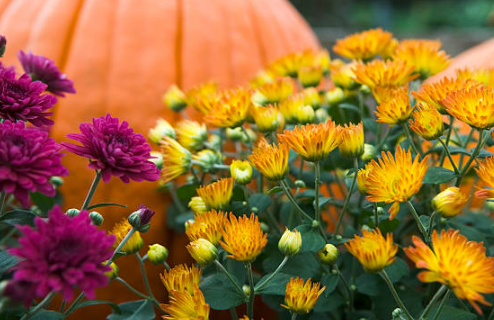Whether you’re growing mums in your garden or displaying them in pots, their colorful blooms are a standout feature of fall décor. With proper care—like regular watering and deadheading—potted mums can bloom for weeks or even months.
But mums in containers won’t last forever. Once they begin to fade and wilt, it might be best to get rid of them. You can try transplanting them into the garden to become perennials, especially if they’re planted a few weeks before the first frost. However, small mums (in one-quart pots or smaller) are less likely to survive the winter.
There are a few ways to help your mums stay vibrant all season, but eventually, the blooming slows down. Here are some clear signs your mums are on their way out—and it may be time to let them go.

Your Mums Stop Producing New Blooms
If you’re regularly deadheading your mums, they’ll usually keep putting out new buds for a while. But once that stops, it’s a sign they’re losing steam. When new buds are slow to appear or stop forming altogether, keep removing spent flowers—but understand the plant is nearing the end of its bloom cycle.
The Flowers Turn Mostly Brown
Even with regular maintenance, your mums will eventually show age. If most of the blooms have turned brown and the plant’s overall color is fading quickly, that’s a strong indicator it’s time to toss them.
The Leaves Look Tired or Faded
Healthy mum leaves are medium to dark green, with a firm, slightly glossy surface. If the leaves start to dull or discolor, it could mean the plant’s energy is running low. You can prune unhealthy leaves, but once more leaves begin to dry out or turn color, the mum is likely done.
The Plant Has Become Root-Bound
Mums are popular fall decorations—some people leave them in nursery pots, while others replant them into baskets or containers. Larger mums are especially prone to becoming root-bound.
Keeping the soil moist and moving them to a bigger pot with more soil can help. But if the soil feels hard and compacted, and the roots are tightly packed, the plant likely can’t absorb water properly anymore. In that case, it might not be worth trying to save it.

Powdery Mildew Shows Up on the Leaves
Late in the season, potted mums may develop powdery mildew on their leaves, especially if airflow is poor. This fungal issue is common in crowded, dense plants like large garden mums—and also affects other garden favorites like peonies and phlox.
You can help prevent mildew with regular pruning and deadheading. But once it sets in, there’s not much to do besides trimming off the affected leaves as best you can.
The Plant Feels Dry or Brittle
If your mums feel dry, and the leaves or blooms are crisp, easily snapping or falling off, that’s a strong sign they’re nearing the end of their life. Even with consistent watering, root-bound mums often struggle to absorb moisture.
You can try breaking up the root ball and transplanting into a larger container with fresh soil. If conditions are right, you might even be able to transition your mum to the garden and grow it as a perennial next year.

